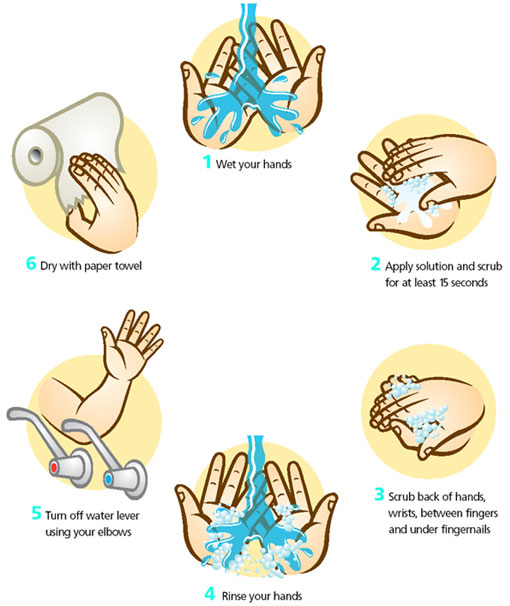هذا شرح بالفيديو لتسهيل الامور
تم الشرح بالصور لتوضيح الغرض




Hand Washing is the single most important means
of preventing the spread of infection.
Hand washing is a simple habit
that can help keep us healthy.

Clean hands save lives.
Hand washing is basic to food safety, personal health, and disease prevention.
Most people--including children and adults do not wash their hands as often or as well as needed.

Proper hand hygiene is the best way
to mitigate exposure to cold and flu,
and the spread of germs,
bacteria and viruses.
Washing hands with the appropriate soap and
water is the first line of defense.


Many illnesses can be avoided if adults,
children and caretakers
simply wash their hands correctly.

Make washing your hands the FIRST THING you do
when you return home from any activity outside the house.
Make it a regular practice to wash your hands as soon as you come in the door.
When should you wash your hands?
Wash your hands before you...
Prepare or eat food
Treat a cut or a wound
Wash your hands after you...
Go to the bathroom
Wash your hands thoroughly after your business.
ALWAYS
wash your hands before leaving the toilet.
On your way out, for personal hygiene, use a paper towel to grip the door handle if possible – (because we will never train everyone to wash their hands) or elbow through when somebody opens it from outside.
Wash your hands after you...
Handle uncooked foods, particularly raw meat,
poultry or fish
Change your children's diapers
Blow your nose, cough or sneeze
Play with your pet animals
Play/Work in the garden
Take out the rubbish
Of course, it's always important to wash your hands
whenever they look or feel dirty.
A simple way to stay healthy

Hand washing doesn't take much time
or effort,
but it offers great rewards in terms of preventing illness.
Adopting this simple habit
can play a major role in protecting our health.

وهذا تلخيص بالصور


Medical Hand Washing
Purpose: To maintain hands free of visible soiling.
Steps
1. Gather the necessary supplies. Stand in front of the sink. Do not allow
your clothing to touch the sink during the washing procedure.
2. Remove jewellery, if possible, and secure in as safe place or allow plain
wedding band to remain in place.
3. Turn on water and adjust force. Regulate the temperature until the
water is warm. (optional)
4. Wet the hands and wrist area. Keep hands lower than elbows to allow
water to flow toward fingertips.
5. Use about 1 teaspoon liquid soap from dispenser or rinse bar of soap and lather thoroughly. Cover all areas of hands with the soap product. Rinse soap bar again and return to soap dish.
6.With firm rubbing and circular motions, wash the palms and backs of
the hands, each finger, the areas between the fingers, the knuckles,
wrists, and forearms. Wash at least 1 inch above area of
contamination. If hands are not visibly soiled, was to 1 inch above
wrist.
7. Continue this friction motion for at least 15 seconds.
8. Use fingernails of the opposite hand or a clean orangewood stick to
clean under fingertips.
9. Rinse thoroughly with water flowing towards fingertips.
10.Pat hands dry, beginning with the fingers and moving upward towards
forearms, with a paper/ hand towel and discard immediately. Use
another clean towel to turn off the faucet. Discard towel immediately
without touching other clean hand.



















